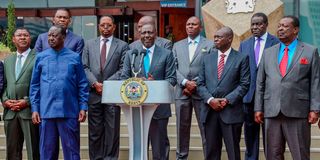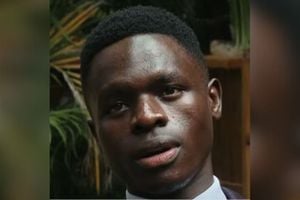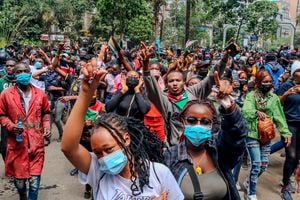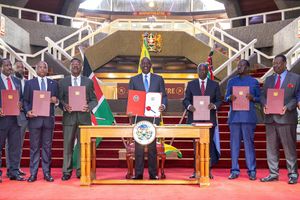
President William Ruto addresses journalists at KICC, Nairobi flanked by his deputy Rigathi Gachagua, Azimio leader Raila Odinga and other national leaders on July 9, 2024.
President William Ruto on Tuesday announced plans for a “broad-based political arrangement”, lending credence to reports he is planning to co-opt the Orange Democratic Movement (ODM) led by veteran opposition leader Raila Odinga into his besieged Kenya Kwanza administration.
The Nation has learnt that the President is toying with the idea of a ‘government of national unity’ and might consider bringing opposition figures into his administration as a way out of the political crisis triggered by the protesting youths, who have demanded a major re-organisation of his government.
“As a way of charting the future from the current situation we are facing, I welcome leaders and other stakeholders, for us to work together and address the current economic situation through a broad-based political arrangement to rally the country forward,” said President Ruto.
“The spirit of Nadco is the spirit of unity, bipartisanship and consensus building, values which have helped our nation overcome its most challenging moments... I look forward to supporting and facilitating any other outputs of national consensus to ensure that Kenya moves forward with as many hands on deck as possible,” he said.
Dr Ruto is said to have dangled at least three Cabinet slots to ODM among other key positions.
His announcement has since triggered a flurry of protests, especially from some opposition leaders led by Narc boss Martha Karua, Eugene Wamalwa (DAP-K) and Jubilee secretary-general Jeremiah Kioni, who accused the political class of trying to hijack the clamour for reforms by Gen Z for self-benefit.
Dr Ruto made the announcement that could have far-reaching political implications while in the company of Mr Odinga at the Kenyatta International Convention Centre (KICC) following a closed-door meeting on a day he also assented to the Independent Electoral and Boundaries Commission (IEBC) Amendment Bill, a product of the National Dialogue Committee (Nadco).
Wiper leader Kalonzo Musyoka, who co-chaired Nadco that birthed the Bill, was present during its signing, but was conspicuously missing in a group photo session thereafter.
In the photo, Mr Odinga was with his ODM brigade, including National Assembly Minority Leader Opiyo Wandayi, Minority Whip Junet Mohammed and ODM deputy party leaders Hassan Joho and Wycliffe Oparanya.
On his part, Dr Ruto was with his deputy Rigathi Gachagua, Prime Cabinet Secretary Musalia Mudavadi, National Assembly Majority Leader Kimani Ichung’wah and Speakers Moses Wetang’ula (National Assembly) and Amason Kingi (Senate).
Asked why Mr Musyoka was missing from the photo, an official of Wiper party described the session as an affair of “ODM and UDA”, further lending credence to a possible political deal between the two parties.
The Nation has also learnt that Dr Ruto and Mr Odinga held a late night meeting on Monday ahead of yesterday’s event. Details of the meeting, however, remained scanty.
Interviews with key figures in Mr Odinga’s side indicated that discussions about a possible government of national unity have been ongoing in the last couple of weeks.
The officials also indicated a split within the party of the decision by Mr Odinga to work closely with Dr Ruto, who is facing a major political storm over unpopular government policies.
An ODM official, who indicated his reservation about the political deal, told the Nation that some names from ODM have since been floated to join the Cabinet.
Other individuals could also be considered for other positions, including Principal Secretaries, said the source.
“Those talks have been there. I have heard about some names being proposed to take up some positions in government. Personally, I do not think it is the right thing to do at this time,” said the official.
President Ruto is under pressure to reorganise his government following weeks of youth-led protests that forced him to withdraw the Finance Bill, 2024.
On Friday, during an address to the nation, President Ruto said he would be making changes to the government “shortly”.
Sources said he was planning for a Parliamentary Group meeting of his Kenya Kwanza alliance before he can make the changes.
It would not be the first time Kenya is having a government of national unity.
When then-President Mwai Kibaki lost the 2005 referendum to the NO camp that was led by his then-Cabinet Minister Odinga, he responded by dissolving his Cabinet. When he reconstituted it two weeks later, Mr Odinga and his Liberal Democratic Party (LDP) members were left out.
“Following the results of the referendum, it has become necessary for me, as the President of the Republic, to reorganise my government to make it more cohesive and better able to serve the people of Kenya,” Mr Kibaki said.
“I have directed that the offices of all ministers and all assistant ministers become vacant. Consequently, the occupants of the said offices cease to hold their respective offices with immediate effect,” he said.
Mr Odinga was yesterday under sharp criticism following his endorsement of dialogue under Dr Ruto’s proposed National Multi-Sectoral Forum that will be held for six days, starting Monday.
“I am happy to confirm that we have had consultations and we have agreed that dialogue is the way forward out of the crisis that we’re having today in our country.
“We are at a crossroads in the country and times like these require leadership for the country to move forward. We require a wider engagement so that people have an opportunity to vomit all that is in their chests in order to find a way forward,” said Mr Odinga.
But Ms Karua, Mr Wamalwa and Mr Kioni questioned his decision on the matter in what portends a major split in the opposition Azimio la Umoja One Kenya. Mr Wamalwa said “I am not boarding” in rejection of the new calls for dialogue. Ms Karua described the calls for another round of dialogue a “trap”.
“Dialogue can only be meaningful if the players have good faith and are guided by the best interests of the people. Let’s be careful as the political class lest we hijack the genuine clamour for accountability and reforms by Gen Z,” said Ms Karua. Mr Kioni described the deal as a tactic for political survival against the nationwide protests by the youth.
“The guardians of the Kenyan state wield their power relentlessly to ensure its survival against any violent threat that could undermine its very foundations. They strategically deploy the political class like pawns, engaging them in different actions disguised as necessary measures in the name of dialogues and reports that push the boundaries of acceptable violence and political grandstanding,” said Mr Kioni.
But Interior Cabinet Secretary Kithure Kindiki described the move by Dr Ruto and Mr Odinga as a relief for the country in the face of existential threat to its stability.
“Kenya has a way of navigating through difficult and trying moments… the commitment by President Ruto and ODM leader Raila Odinga to continuous dialogue, offers relief to a nation in search of consensus and a broad based political route for addressing priority matters of creation of jobs and income opportunities for the youth, the debt burden, public expenditure cuts, and the fight against corruption,” said Prof Kindiki.








